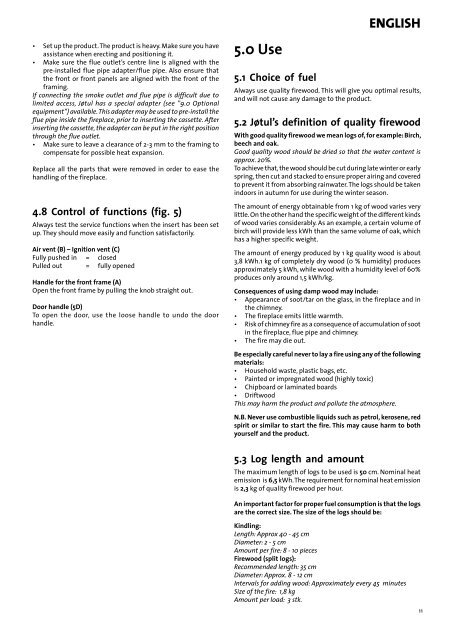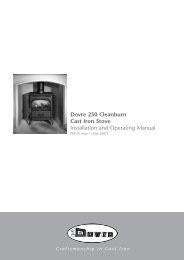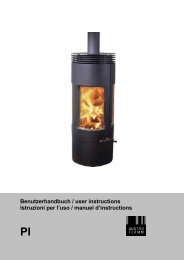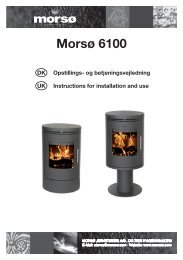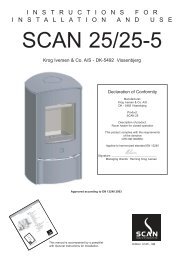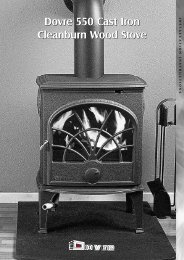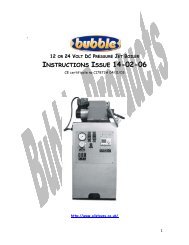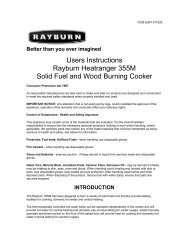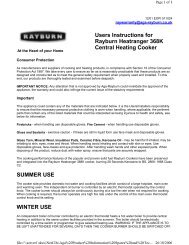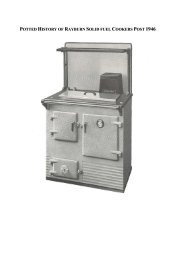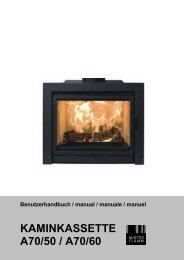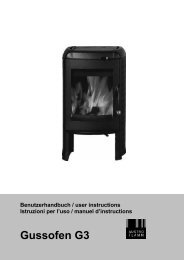Jøtul C 21 / C 22
Jøtul C 21 / C 22
Jøtul C 21 / C 22
- No tags were found...
Create successful ePaper yourself
Turn your PDF publications into a flip-book with our unique Google optimized e-Paper software.
english• Set up the product. The product is heavy. Make sure you haveassistance when erecting and positioning it.• Make sure the flue outlet’s centre line is aligned with thepre-installed flue pipe adapter/flue pipe. Also ensure thatthe front or front panels are aligned with the front of theframing.If connecting the smoke outlet and flue pipe is difficult due tolimited access, Jøtul has a special adapter (see ”9.0 Optionalequipment”) available. This adapter may be used to pre-install theflue pipe inside the fireplace, prior to inserting the cassette. Afterinserting the cassette, the adapter can be put in the right positionthrough the flue outlet.• Make sure to leave a clearance of 2-3 mm to the framing tocompensate for possible heat expansion.Replace all the parts that were removed in order to ease thehandling of the fireplace.4.8 Control of functions (fig. 5)Always test the service functions when the insert has been setup. They should move easily and function satisfactorily.Air vent (B) – Ignition vent (C)Fully pushed in = closedPulled out = fully openedHandle for the front frame (A)Open the front frame by pulling the knob straight out.Door handle (5D)To open the door, use the loose handle to undo the doorhandle.5.0 Use5.1 Choice of fuelAlways use quality firewood. This will give you optimal results,and will not cause any damage to the product.5.2 Jøtul’s definition of quality firewoodWith good quality firewood we mean logs of, for example: Birch,beech and oak.Good quality wood should be dried so that the water content isapprox. 20%.To achieve that, the wood should be cut during late winter or earlyspring, then cut and stacked to ensure proper airing and coveredto prevent it from absorbing rainwater. The logs should be takenindoors in autumn for use during the winter season.The amount of energy obtainable from 1 kg of wood varies verylittle. On the other hand the specific weight of the different kindsof wood varies considerably. As an example, a certain volume ofbirch will provide less kWh than the same volume of oak, whichhas a higher specific weight.The amount of energy produced by 1 kg quality wood is about3,8 kWh.1 kg of completely dry wood (0 % humidity) producesapproximately 5 kWh, while wood with a humidity level of 60%produces only around 1,5 kWh/kg.Consequences of using damp wood may include:• Appearance of soot/tar on the glass, in the fireplace and inthe chimney.• The fireplace emits little warmth.• Risk of chimney fire as a consequence of accumulation of sootin the fireplace, flue pipe and chimney.• The fire may die out.Be especially careful never to lay a fire using any of the followingmaterials:• Household waste, plastic bags, etc.• Painted or impregnated wood (highly toxic)• Chipboard or laminated boards• DriftwoodThis may harm the product and pollute the atmosphere.N.B. Never use combustible liquids such as petrol, kerosene, redspirit or similar to start the fire. This may cause harm to bothyourself and the product.5.3 Log length and amountThe maximum length of logs to be used is 50 cm. Nominal heatemission is 6,5 kWh. The requirement for nominal heat emissionis 2,3 kg of quality firewood per hour.An important factor for proper fuel consumption is that the logsare the correct size. The size of the logs should be:Kindling:Length: Approx 40 - 45 cmDiameter: 2 - 5 cmAmount per fire: 8 - 10 piecesFirewood (split logs):Recommended length: 35 cmDiameter: Approx. 8 - 12 cmIntervals for adding wood: Approximately every 45 minutesSize of the fire: 1,8 kgAmount per load: 3 stk.11


